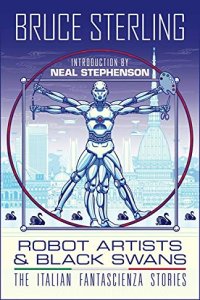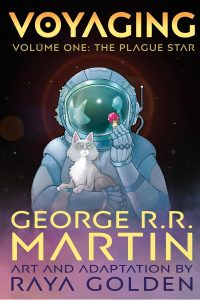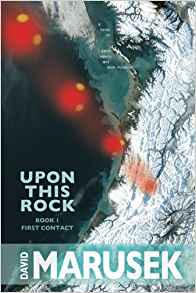Russell Letson Reviews Robot Artists and Black Swans: The Italian Fantascienza Stories by Bruce Sterling
 Robot Artists and Black Swans: The Italian Fantascienza Stories, Bruce Sterling (Tachyon Publications, 978-1616963293, $25.95, 250 pp, hc) March 2021. Cover by John Coulthart.
Robot Artists and Black Swans: The Italian Fantascienza Stories, Bruce Sterling (Tachyon Publications, 978-1616963293, $25.95, 250 pp, hc) March 2021. Cover by John Coulthart.
Few American SF writers are as good at evoking the vibe of parts of the world outside the US as novelist-futurist-journalist Bruce Sterling – it’s something he was working at as far back as Holy Fire (1996), and it became a notable feature of the stories in A Good Old-Fashioned Future (1999) and Gothic High-Tech (2011) and the Eurotrash-hipster-caper novel Zeitgeist (2000). For quite a while Sterling has been a peripatetic more-or-less expatriate, living in various parts of Europe, especially in Turin, and eventually he invented “Bruno Argento,” an Italian alter ego and nom de plume (or perhaps I should write pseudonimo) who has, over the last decade or so, been producing examples of fantascienza, as the Italians call science fiction.
Gothic High-Tech and Pirate Utopia (2016) showcased some of this work, and now there is a new collection, Robot Artists and Black Swans, which gathers seven fantascienza pieces in a snazzily executed volume with lots of literary and decorative extras: a foreword by “Bruno Argento” himself, an introduction by Neal Stephenson, an afterword by Italian SF writer Dario Tonani, and interior illustrations by cover artist John Coulthart.
The stories merge Sterling’s familiar cyberpunkish SF with Continental traditions, from 19th-century gothic and fantastika to 20th-century postmodern fabulists. It’s also interesting how many of the stories are built around debates or conversations. The introductory short piece, “Kill the Moon”, is a plotless monologue that sets up one of the volume’s themes: the flair and style – the Italianness – of Italian culture. In 2061, the narrator complains, the world “thinks that space travel is old-fashioned and adorable” and that his nation’s moon landing is “an empty-headed lark.” Nevertheless, everyone does admire the Italian space program “in the same way that they admire our unique penchant for grappa, Baroque architecture, and labor demonstrations,” as a charming anachronism.
The more common pattern is to spin out a slender filament of plot along which are strung encounters, conversations, arguments, declarations, and manifestos, all of which foreground narrative and character voice. Even the most plotty tales – the alternate-historical “Black Swan”, the deal-with-the-devil “Esoteric City”, and the Euro-futurist “Robot and Roses” – are punctuated by stretches of conversation, argument, and commentary as the characters move toward their appointed ends. I still hear echoes of the accent and attitudes of the Texas hipster/Wired correspondent who produced The Hacker Crackdown years ago: an avant-garde-jazzy drawl, playful and ironic and knowing. But in these stories, that morphs into something more “literary,” more academic, often with a translated-into-English feel that still manages to be hep to the jive of whatever past or future or alternate-history period is being portrayed.
Some of the stories do carry the expected Sterling-the-futurist insights and observations; “Black Swan” projects a range of possible futures where its hack-journalist narrator might have been a genius inventor and “guru of computational aesthetics,” or the President of France might be a thuggish international criminal, or Italo Calvino might have been a great physicist who invented a better (because Italian) internet. “Elephant on the Table” offers a satirical picture of a world dominated by an AI-run “big-data market capitalism” that produces a Transparent Society where invisibility is neither expected nor particularly desired – except by the Chief, a senile centenarian ex-politician whose surveillance-proof Shadow House is “the state of the art in confidential living and reputation management.”
In “Robot in Roses”, two representatives of rival 22nd-century cultural factions engage in a running debate about art and science in which both sides come across as caricatures, spouting canned arguments about their respective epistemologies and worldviews as they pursue the Winkler, a liberated robot wheelchair that may or may not represent a “Third Order of Being”: neither alive nor sentient but somehow capable of surprising, art-like constructions. Wolfgang wants to publish a career-making critical-aesthetic understanding of the Winkler; post-human junior scientist Jetta, equally careerist, wants to debunk and destroy it. The setting for their arguments is the Italy of the Anthropocene Age, the result of ecological upheavals and technological miracles.
Italy had become one vast botanical lesson in eco-globalization. Great cosmopolitan jungles flourished in the peninsula, amazing thickets of black locust, ailanthus, kudzu, and bamboo…. These new masters of the Anthropocene world, the survivors of the big extinctions, were invasive species, mostly: the parvenu squatters of the vegetable kingdom.
Meanwhile, in cities like urbane Verona and ancient, battered Rome, old social patterns persist, enhanced – or ignored – by global high technologies.
When those same sharp eyes are turned on the past, the results head toward the territory of Neal Stephenson’s Baroque Cycle: historical reimaginings with a postmodern twist. In “Pilgrims of the Round World”, the planned retirement (via pilgrimage) of 15th-century innkeepers Ugo and Agnes gets interrupted by a parade of unexpected visitors, estranged relatives, aristocratic refugees, and other intruders. Not that the couple had ever lacked for wide-ranging and varied companionship. On their last night as hosts, the guests include:
a wandering Jew, an Arab astrologer, a German printer, and a battle-scarred Serbian Ottoman… a Portuguese slave dealer, a Waldensian heretic, an Alpine brigandess, and the madam of a Turinese brothel.
Among others. But then, this is Turin, a crossroads for travelers from the Alps to Constantinople, and Ugo and Agnes are socially flexible enough to hobnob with pretty much anyone from anywhere. The various interruptions and alterations to their travel plans constitute the one-thing-after-another story line, which in turn provides opportunities for conversations about dynastic politics, international trade, the domestic maintenance of high-born folk, the provenance of the Shroud of Turin (and young da Vinci’s role in its production), the patronage of Popes and anti-Popes, and Jesus’s own hand-written travel diary (guaranteed genuine). Everything, it appears, is up to date in 15th-century Turin.
“The Parthenopean Scalpel” is the memoir of a Carbonari assassin on the run from a botched killing (right victim, wrong means and operative), hiding out in Tuscany and fretting that he can’t get in on the action in Milan, where the 1848 anti-Austrian revolution is in full swing. But the political intrigue and violence are background to the narrator’s reflections on his high standards of professional conduct, his philosophical musings, and eventually his passion for the reclusive and very strange sister (or sisters) of his host and protector. What starts out as an intellectualized proto-intrigue thriller winds up deep in gothic territory even before an uncanny Austrian agent shows up to finish the drama and push it all the way into the fantastic.
“Esoteric City” offers a different flavor of the gothic, as auto-company magnate (and occult master) Occhietti is summoned for a meeting with his infernal bosses down in the Turinese branch of hell, guided not by Virgil but by the reanimated 3,000-year-old mummy of an Egyptian priest who misses being merely dead (his heart isn’t in it – because it’s stored in a jar in the local museum). The task Occhietti is given is even worse than visiting hell: he has to take a meeting with Satan himself, who turns out to be quite the model of the “modern post-industrialist,” a Green enthusiast who speechifies that everyone “tick off every box on the sustainability to-do list” and recommends memorization of:
the Three Main Components of the Four System Conditions of the Natural Step. And, of course, the Ten Guiding Principles to One-Planet Living. I trust you’ve read the World Wildlife Fund’s Three Forms of Solidarity?
Even more enumerated and capitalized listicles follow before Occhietti interrupts to conduct his dreaded interview, which, predictably, does not go as anticipated.
I put off reading Stephenson’s introduction and Tonani’s afterword until I had a solid draft of this review. Just as well, since their observations are so on-the-money that I might have been tempted to simply copy and paste them in here. Like Coulthart’s striking black-and-white illustrations, they offer illuminating context for a set of stories that show how widely Sterling’s imagination and craft can range across geographies, histories, rhetorics, and genres.
Russell Letson, Contributing Editor, is a not-quite-retired freelance writer living in St. Cloud MN. He has been loitering around the SF world since childhood and been writing about it since his long-ago grad school days. In between, he published a good bit of business-technology and music journalism. He is still working on a book about Hawaiian slack key guitar.
This review and more like it in the May 2021 issue of Locus.
 While you are here, please take a moment to support Locus with a one-time or recurring donation. We rely on reader donations to keep the magazine and site going, and would like to keep the site paywall free, but WE NEED YOUR FINANCIAL SUPPORT to continue quality coverage of the science fiction and fantasy field.
While you are here, please take a moment to support Locus with a one-time or recurring donation. We rely on reader donations to keep the magazine and site going, and would like to keep the site paywall free, but WE NEED YOUR FINANCIAL SUPPORT to continue quality coverage of the science fiction and fantasy field.
©Locus Magazine. Copyrighted material may not be republished without permission of LSFF.







